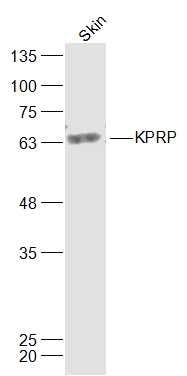The nuclear import of karyophilic proteins is directed by short amino acid sequences termed nuclear localization signals (NLSs). Karyopherins, or importins, are cytoplasmic proteins that recognize NLSs and dock NLS-containing proteins to the nuclear pore complex. The protein encoded by this gene shares the sequence similarity with Xenopus importin-alpha and Saccharomyces cerevisiae Srp1. This protein is found to interact with the NLSs of DNA helicase Q1 and SV40 T antigen. [provided by RefSeq, Jul 2008]
Function:
Functions in nuclear protein import as an adapter protein for nuclear receptor KPNB1. Binds specifically and directly to substrates containing either a simple or bipartite NLS motif. Docking of the importin/substrate complex to the nuclear pore complex (NPC) is mediated by KPNB1 through binding to nucleoporin FxFG repeats and the complex is subsequently translocated through the pore by an energy requiring, Ran-dependent mechanism. At the nucleoplasmic side of the NPC, Ran binds to importin-beta and the three components separate and importin-alpha and -beta are re-exported from the nucleus to the cytoplasm where GTP hydrolysis releases Ran from importin. The directionality of nuclear import is thought to be conferred by an asymmetric distribution of the GTP- and GDP-bound forms of Ran between the cytoplasm and nucleus. In vitro, mediates the nuclear import of human cytomegalovirus UL84 by recognizing a non-classical NLS. In vitro, mediates the nuclear import of human cytomegalovirus UL84 by recognizing a nonclassical NLS.
Subcellular Location:
Cytoplasm. Nucleus.
Tissue Specificity:
Highly expressed in testis, ovary, small intestine, heart, skeletal muscle, lung and pancreas, but barely detectable in kidney, thymus, colon and peripheral blood leukocytes.
Similarity:
Belongs to the importin alpha family.
Contains 10 ARM repeats.
Contains 1 IBB domain.
SWISS:
O00629
Gene ID:
3168
Database links:
Entrez Gene: 3168 Human
Entrez Gene: 535090 Cow
Entrez Gene: 478136 Dog
Entrez Gene: 100171548 Orangutan
Entrez Gene: 100349259 Rabbit
Entrez Gene: 702486 Rhesus monkey
Omim: 602970 Human
SwissProt: O00629 Human
Unigene: 288193 Human
| Picture |
Sample: heart (mouse) Lysate at 40 ug
Primary: Anti-KPNA4(SL3364R) at 1/300 dilution
Secondary: IRDye800CW Goat Anti-Rabbit IgG at 1/20000 dilution
Predicted band size: 57 kD
Observed band size: 57 kD
|
|
|
